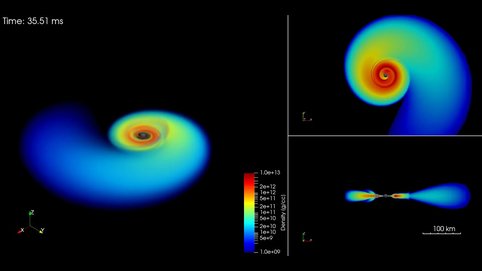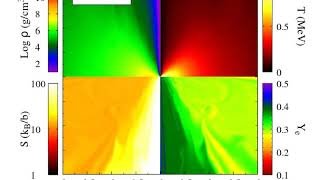Research results and animations
2025
Jet and black hole formation from a binary neutron star merger
An international team led by researchers at the Max Planck Institute for Gravitational Physics (Albert Einstein Institute) has performed the longest and most complex simulation to date of a binary neutron star merger, lasting 1.5 seconds of real time.
Jet and black hole formation from a binary neutron star merger
Publication:
2024
The dynamo that generates large-scale magnetic fields in merging neutron stars
What fuels the powerful engine of neutron star mergers?
Publication:
2023
Numerical-relativistic simulation of a binary neutron star merger
The visualization shows the electron fraction on the left, the density in the center, and the magnetic field strength (1015 Gauss) on the right.
Second-long numerical-relativistic simulation of a binary neutron star merger
The visualization shows profiles for rest-mass density (top-left), magnetic-field strength (top-second from left), magnetization parameter (top-second from right), unboundedness defined by the Bernoulli criterion (top-right), electron fraction (bottom-left), temperature (bottom-second from left), entropy per baryon (bottom-second from right), and Shakura-Sunyaev αM parameter (bottom-right).
Publication:
2022
General-relativistic neutrino-radiation magnetohydrodynamic simulation of seconds-long black hole-neutron star mergers
Numerical simulation of a black hole-neutron star merger
Publication:
2021
Properties of the remnant disk and the dynamical ejecta produced in low-mass black hole-neutron star mergers
Merger of a low-mass black hole and neutron star leading to a black hole surrounded by an accretion disk
Publication:
2020
Mass ejection from disks surrounding a low-mass black hole: Viscous neutrino-radiation hydrodynamics simulation in full general relativity
Viscous evolution of disks for Mdisk = 0.1 M⊙
Publication:






